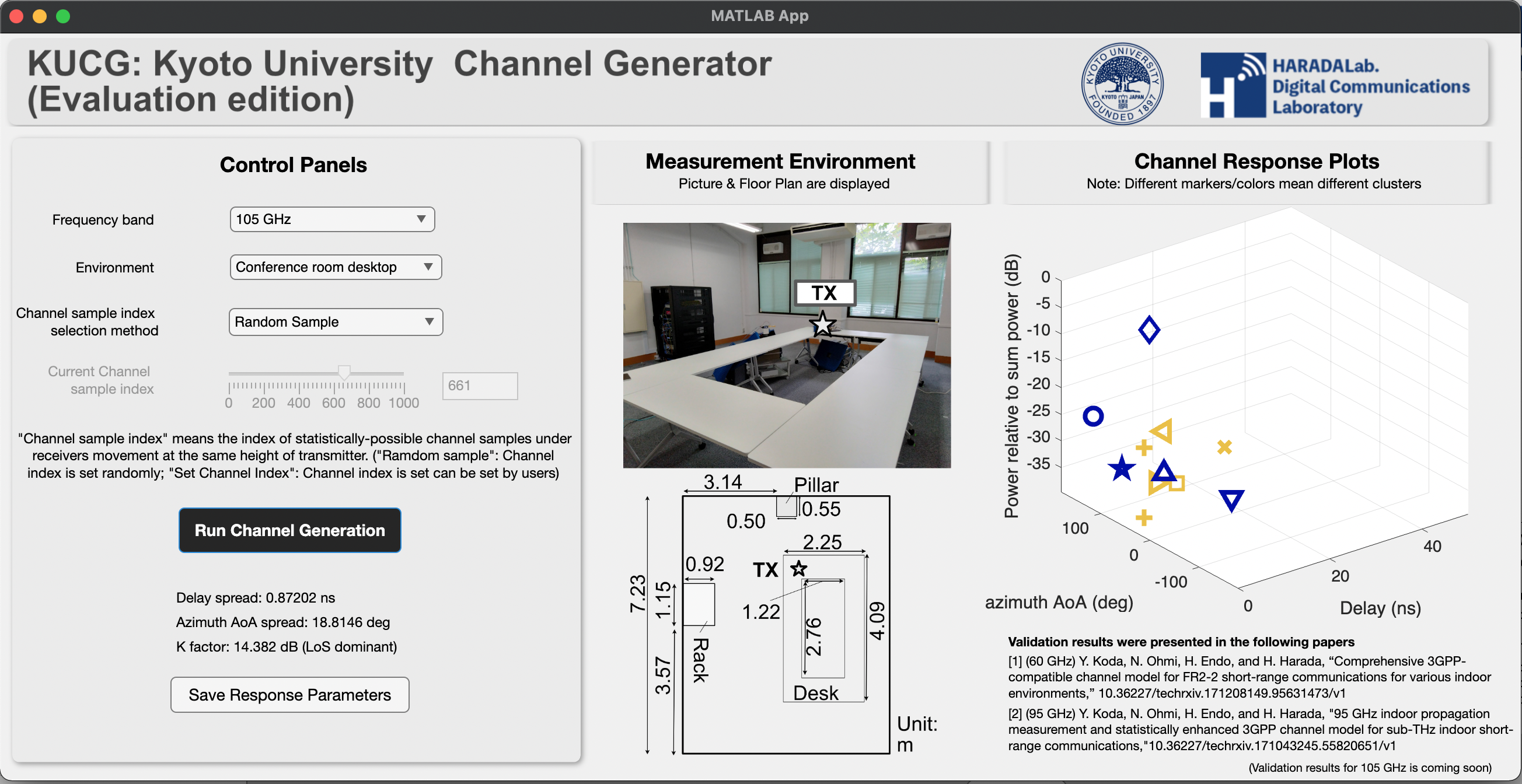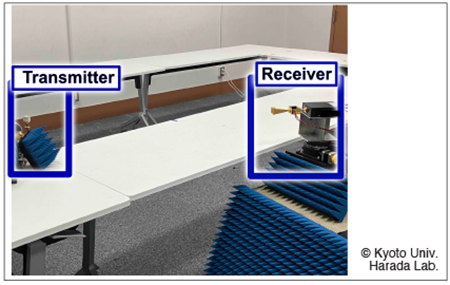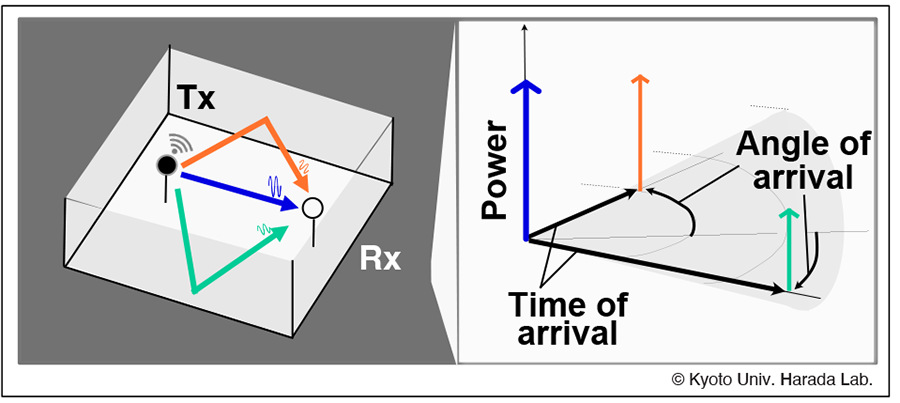






[Home] » [Press Release]
Sub-THz propagation channel simulator for 6th-gen mobile communication systems R&D
|
A research group led by Professor Hiroshi Harada, Assistant Professor Yusuke Koda, and Researcher Norichika Ohmi at the Graduate School of Informatics, Kyoto University, has developed a radio wave propagation simulator named Kyoto University Channel Generator (KUCG) for the sub-terahertz (sub-THz) band. The sub-THz band, ranging from approximately 100 GHz to 300 GHz, is expected to solve future frequency band shortages by supplementing the sub-6 GHz and millimeter wave bands used in the 5th generation mobile communication system (5G). The developed simulator can iteratively generate samples of radio propagation characteristics that are statistically consistent with the results of sub-THz band propagation measurement tests conducted by the research group. This allows anyone to evaluate the transmission characteristics of various sub-THz wireless systems using only a computer, without conducting actual field tests. This breakthrough is expected to accelerate the research and development of wireless transmission methods using sub-THz waves. The evaluation version of the simulator has been released on the website of the research group. [KUCG Page] https://www.dco.cce.i.kyoto-u.ac.jp/en/wp/ku-gen/kucg/ |

|
Background
The 5th generation mobile communication system (5G), which was launched as a commercial service in March 2020, is expected to further advance as infrastructure supporting future industries and social life with high-speed, high-capacity, low-latency, and multi-connection communication. For this advancement, an enhanced utilization of the sub-6 GHz band and millimeter wave band, which are currently allocated for the 5G, is initially required. However, as advancements continue, even these bands may become insufficient, necessitating the exploration of additional frequency resources. The sub-terahertz (sub-THz) band, ranging from approximately 100 GHz to 300 GHz, is gaining attention in the research and development of the next-generation 6th-generation mobile communication system (6G) (See Fig. 1).

|
For evaluating the radio transmission characteristics using sub-THz waves, a promising approach is to prototype a sub-THz radio device and conduct field tests. However, this requires a significant set-up cost, making it difficult for many radio communication designers to conduct. If there is a simulator that can simulate various characteristics of sub-THz wave propagation on a computer, it is possible to easily and comprehensively evaluate the transmission characteristics of various wireless systems on a computer. However, such a radio wave propagation simulator compatible with the sub-THz band has not been widely available.
Research Methods and Results
The research group developed the simulator named Kyoto University Channel Generator (KUCG) by constructing statistical models of various parameters characterizing radio wave propagation obtained from sub-THz band propagation measurements and designing algorithms to repeatedly generate numerical samples of sub-THz wave propagation characteristics on a computer. The main research and development efforts included:
- Developing a channel sounding system for measuring propagation characteristics of wideband signals at 105 GHz (a sub-THz band frequency) and 60 GHz (a millimeter wave band frequency) and conducting propagation characteristic measurements in various indoor and outdoor environments (See Fig. 2).
- Constructing statistical models for three parameters characterizing the arrival characteristics of radio waves (arrival time, angle of arrival, and power) from these measurement tests. (See Fig. 3)
- Designing algorithms to repeatedly generate numerical samples of sub-THz wave propagation characteristics on a computer based on the constructed statistical models.
- Developing an application to easily execute the designed generation algorithms with a single click.

|

|
The significance of this development lies in the invention of foundational technology that realizes wireless transmission evaluation in the sub-THz band on a computer. Generally, to design a better wireless transmission method, it is required to first try and evaluate various wireless transmission methods before conducting actual transmission tests. The radio wave propagation simulator KUCG plays an important role as a foundational technology that facilitates the design of wireless transmission schemes in the yet-to-be-explored sub-THz band, thereby promoting the development of next-generation wireless communication technology.
Impacts and Future Plans
The developed simulator allows easy evaluation of radio transmission characteristics using sub-THz waves only with a computer. This development is expected to accelerate research and development of wireless transmission methods using sub-THz waves. The future plans of the research group include expanding KUCG to support a wider range of scenarios and frequency bands.
Acknowledgements
These results were partly obtained from the commissioned research (No. JPJ012368C04201) by the National Institute of Information and Communications Technology (NICT), Japan. A part of this research is also supported by the Ministry of Internal Affairs and Communications in Japan (SCOPE #JPJ00595)
Terminologies
» 1. Sub-6 GHz band is referred to as the frequency band that lies lower than 6 GHz. Generally, in Japan, the sub-6 GHz band is referred to as the band of 3.6–4.1 GHz and 4.5–4.9 GHz, which were additionally allocated for the 5G communication systems.
» 2. Millimeter wave band is referred to as the frequency band ranging from 30 GHz to 300 GHz by definition. Additionally, the 28 GHz band, which is widely allocated for the 5G communication systems, is also referred to as a part of the millimeter wave band. However, it should be noted that the band of 100 GHz–300 GHz inside the millimeter wave band is not explored for commercial use, and this band is particularly referred to as the “sub-THz band” to distinguish it from the 5G millimeter wave band.
Comments from a Researcher
"As wireless communication systems become integrated into social infrastructure in the future, there is a concern that available frequency bands will become congested, necessitating the exploration of additional frequency bands for 6G. The sub-THz band is highly attractive due to its wide bandwidth availability and minimal competition from other wireless systems. However, sub-THz waves have different characteristics from the radio waves used in previously utilized frequency bands, and we need to study these characteristics, model them, and develop simulators; otherwise, the subsequent design of wireless communication systems cannot be carried out correctly. With the KUCG developed in this project, we hope that more wireless communication designers will be able to take on the challenge of designing wireless communication using sub-THz waves, further invigorating research and development." (Yusuke Koda)
|
Contact Information |
|
[For Research Inquiries] Graduate School of Informatics, Kyoto University, Course of Communications and Computer Engineering, Harada Lab. Yusuke Koda and Hiroshi Harada TEL:075-753-5318 E-mail:contact [at] dco.i.kyoto-u.ac.jp |
|
[For Press and Media Inquiries] *Please change [at] to @ |